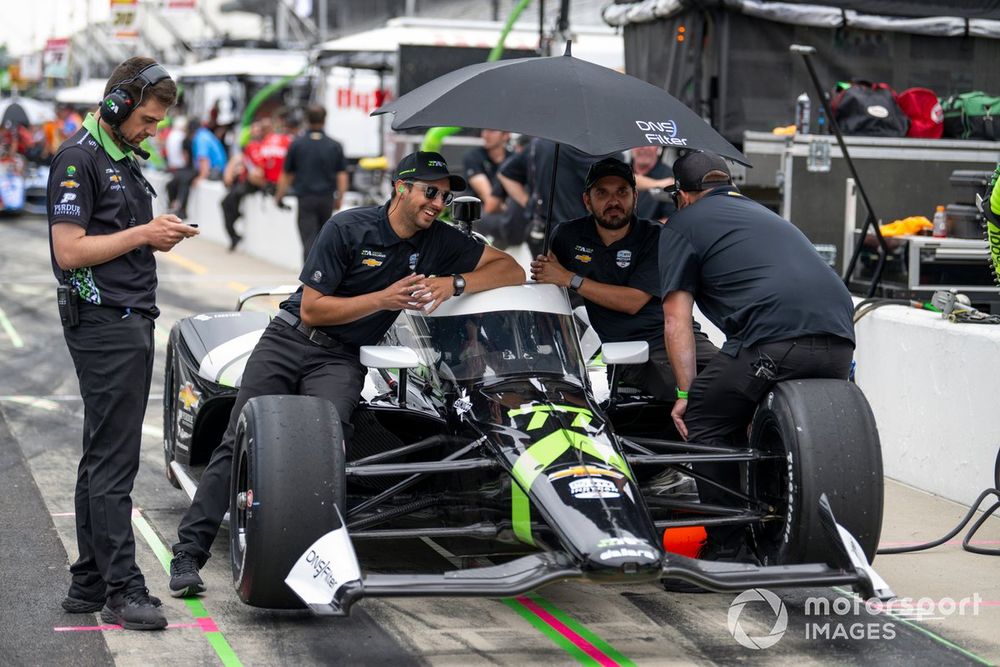Brad Hollinger is among the few that have seen the world of Formula 1 and the IndyCar Series from an ownership perspective.
In 2014, the Pennsylvania native dove into the pinnacle of motorsport and became the second-largest shareholder and a board member at Williams. He spent six years with the team before selling off his 15% share and then in 2021 invested in a vision presented by Ricardo Juncos and became co-owner of Juncos Hollinger Racing (JHR) and jumped into the IndyCar Series.
In nearly three full-time seasons in IndyCar, JHR has ascended up the grid year-on-year, to the point of nearly touching the podium just two races ago after Romain Grosjean captured fourth place at Laguna Seca and recorded the team’s best-ever result.
With significant time now spent in both F1 and IndyCar, Hollinger recently talked exclusively with Autosport to share his thoughts on how the two single-seater categories compare.
“In some ways it’s almost identical,” Hollinger said. “The enjoyment, the passion, the thrill, it’s very similar, no doubt. I happened to hit it quite perfectly with Williams. Williams had floundered after the BMW deal, then they brought in Toto Wolff and he made some changes, all for the good. Brought in Pat Symonds, who did a great job.

The Williams team celebrate a podium finish for Valtteri Bottas, Williams F1, 3rd Position
Photo by: Glenn Dunbar
“The first race I went to after I bought in, in 2014, was Austria; we qualified first and third. We ended up third that season, third the next season. So, it was quite a good fairytale to say the least.
“Then, as they tend to do in Formula 1, the money dried up a bit. Claire [Williams] took over for her dad and it became difficult to be competitive. That was not so fun. It became more of a pure business and a whole lot less a fun, passionate sport.”
And that’s what forced Hollinger to look at IndyCar.
“Compare that to IndyCar where, a brand new team — Ricardo did a great job setting up an Indy NXT organisation, but I know he’d done one race, the Indy 500, a couple of years before in IndyCar,” Hollinger said.
“He wanted to get into IndyCar, I said, ‘Yeah, I’d love to as well’ coming from Formula 1. It’s meaningfully different. The racing, to me, is infinitely better. It’s fiercely competitive and close, but the atmosphere I love because, to me, it’s much more collegial, much more open, not so much this cloak-and-dagger shit that you have in Formula 1. Like, my God, you can’t take a picture; they hide everything. It’s like, ‘For God’s sake guys, it’s racing!’
“So, it’s just a much more collegial atmosphere, I find. In IndyCar, people help each other out. Yeah, there’s a bit of cut-throat and drivers changing hands and all that good kind of stuff. That’s normal in any sport, whatever it is, whether it’s football, soccer, basketball. So, I really enjoy IndyCar. IndyCar is just flat out more fun.”

Romain Grosjean, Juncos Hollinger Racing Chevrolet
Photo by: Geoffrey M. Miller / Motorsport Images
Taking learnings from F1 to build-up JHR
This year, in particular, has seen JHR make significant moves to propel the organisation forward.
Over the offseason they brought in Mark Myers, a veteran of 22 years in motorsports on both the agency and team side, including nearly four years with Arrow McLaren, to take on the role of chief marketing officer, along with the internal promotion of Lee Zohlman stepping up as the chief commercial officer after serving as the senior partnership advisor.
In May, JHR announced the arrival of David O’Neill, the former Haas F1 team sporting director and team manager, as its new team principal.
Hollinger credits his learnings from F1 as part of knowing what to implement in IndyCar in an effort to find further success.
“Certainly, bringing in David O’Neill has been huge. Mark Myers has been huge,” Hollinger said.
“These are guys that come from significant organisations in Haas and McLaren. They’re doing an organisational structure and template that works really well in racing. To get to the top, I think that’s exactly what it takes.
“Not only do you have to have the right vision, right passion and the right culture, you also have to have an organisation that knows the pecking order, is knowing and doing what their responsibilities are. I think that order is necessary and with the talent we have now, we’ve been able to do that.”








